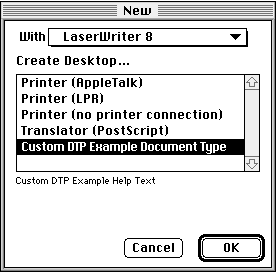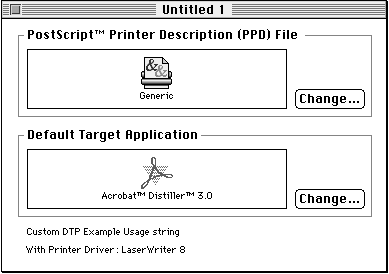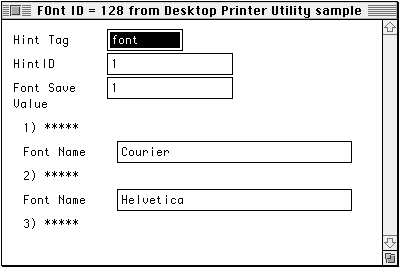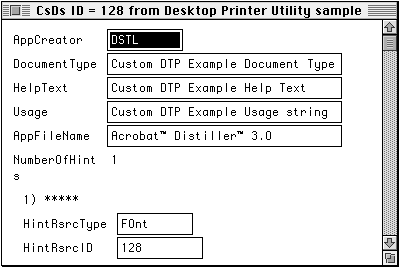Legacy Document
Important: This document is part of the Legacy section of the ADC Reference Library. This information should not be used for new development.
Current information on this Reference Library topic can be found here:
ADC Home > Reference Library > Technical Notes > Legacy Documents > Printing >
Important: This document is part of the Legacy section of the ADC Reference Library. This information should not be used for new development.
Current information on this Reference Library topic can be found here:
|
Customizing the DTP UtilityIn order to add a new custom DTP to the list of supported DTPs in Desktop Printer Utility, you must add resources to the utility's resource fork. Desktop Printer Utility contains templates to ease the creation of these resources. '
|
#define kVariableLen 1
struct CustomAppDesc{
OSType appSignature;
Str255 docType;
Str255 helpText;
Str255 usage;
Str255 appFileName;
short numOfHintsFollow;
HintRsrcSpec hintRsrc[kVariableLen];
};
typedef struct CustomAppDesc CustomAppDesc;
|
appSignature: The application signature of the application to launch.
The LaserWriter driver uses this information to find the application on all
mounted volumes which are available to the user.docType: A string that describes the type of custom DTP.
This string appears
in the list of document types when "New" menu is selected. This string is
highlighted in Figure 1.helpText: This string appears when your custom DTP is selected. This
string will appear in the "New" dialog field just below the DTP choices.
This string appears as 'Custom DTP Example Help Text' in Figure 1.usage: A string that describes the usage of your custom DTP. This string
appears as "Custom DTP Example Usage string" in Figure 2.appFileName: The name of the application to launch. The LaserWriter driver
uses this information to find the application on disks which are available to
the user as well as to provide error messages to the user (e.g. "SurfWriter
could not be launched due to insufficient memory").numOfHintsFollow: The number of hints provided in the hintRsrc array. See
the "Hints Resources" section for more details.hintRsrc: An array of hints that outlines the kind of
PostScript that should
be generated by the driver. See the "Hints Resources" section for more details.Figure 1

Figure 2

The CustomDTPResource can provide "hints" about the PostScript the
driver should generate. Each "CustomDTPResource" contains the field
"numOfHintsFollow" which represents the number of "hints" provided.
The "hints" data is placed in an array that contains "numOfHintsFollow"
number of copies of the structure:
struct HintRsrcSpec{
OSType rsrcType;
short rsrcID
};
typedef struct HintRsrcSpec HintRsrcSpec;
|
Each entry in the array points to a resource which is converted to a hint in the driver's preferences. The hint resource types, which are currently supported, have the following formats:
pslv' hint specifies the desired
PostScript level.
PSlv'
typedef struct{
OSType hintType; //'pslv' hint type
long hintId; // set to 1
long psLevel;
}PSlvResource;
#define kHintLanguageLevelTag 'pslv'
#define kHintLanguageLevelId 1
|
The possible(current) values for psLevel which can be set are:
|
-3 |
Level 2 and 3 |
|
|
-2 |
Level 1 and 2 |
|
|
-1 |
Unknown Level |
|
|
0 |
Other Level |
//do not use |
|
1 |
Level 1 |
|
|
2 |
Level 2 |
|
|
3 |
Level 3 |
|
|
Note: |
bnok' */This hint allows or disallows the use of binary data in the PostScript file.
BNok'
typedef struct{
OSType hintType; //'bnok' hint type
long hintId; // set to 1
TriState binaryOK;
}BNokResource;
#define kHintADOIsBinaryOKTag 'bnok'
#define kHintADOIsBinaryOKId 1
|
|
0 |
False |
|
|
1 |
True |
|
|
2 |
Unknown |
//do not use |
|
Note: |
jobt' */This hint specifies the type of PostScript to generate.
JObt'
typedef struct{
OSType hintType; //'jobt' hint type
long hintId; // set to 1
char jobType;
}JObtResource;
#define kHintJobTypeTag 'jobt'
#define kHintJobTypeId 1
|
jobType are available:
|
0 |
|
|
1 |
|
font' */This hint specifies the font inclusion. The font handling hint consists of a four-byte flag followed by a list of NULL terminated font names.
FOnt'
typedef struct{
OSType hintType; //'font' hint type
long hintId; //set to 1
long tag;
unsigned char name[1];
}FOntResource;
#define kHintIncludeFontsTag 'font'
#define kHintIncludeFontsId 1
|
|
0 |
|
|
1 |
|
If the flag is 'kIncludeNoFontsOtherThan', the utility will only
include the font definitions of fonts that are listed after the flag. If there
are no font names after the flag, no font resources are included in the output.
If the flag is 'kIncludeAllFontsBut', font resources are included in the output
unless the font names are listed. To include all fonts, use the 'kIncludeAllFontsBut'
flag with no fonts listed afterwards.
Following is a sample of a custom DTP that excludes Courier and Helvetica
from the PostScript file via a 'CsDs' and 'FOnt' resource.
This sample is intended to give developers an idea of how easy it is to customize the DTP Utility.
The first step towards adding the Custom DTP is to create a hint resource
of the correct type. The example shown is the 'FOnt' resource which
provides data about font inclusion.

The second step is to associate the hint with a particular DTP by
adding hint resource information to the 'CsDs' resource for a
particular DTP.

And that's all that is required to get the DTP Utility to create a custom DTP that produces a PostScript file without Courier and Helvetica.
Due to the parallel development schedules of Mac OS 8.0 and LaserWriter 8.5.1, DTP Utility 1.0 (which ships with LaserWriter 8.5.1) will not install on Mac OS 8.0. It will, however, work with the upcoming Mac OS 8.1.
In order to ship a customized DTP Utility with your application, you must license the DTP Utility from Apple. Please contact Apple's Software Licensing group (sw.license@apple.com or 512-919-2645) for more information.
This Technote has described and demonstrated all that is necessary for you to customize Desktop Printer Utility. We encourage all developers to give this a try.
TN 1112: Introducing the LaserWriter Driver Version 8.5.1
|
|
Acrobat version of this Note (300K). |
|